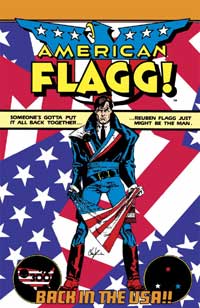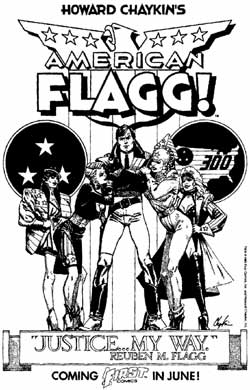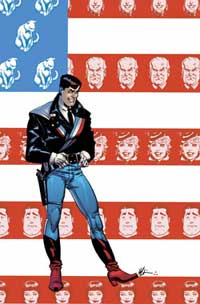Comics /
Cult Favorite
American Flagg!: Long May It Wave
By Philip Schweier
July 18, 2008 - 13:16
Back in the early 1990s, I experienced a brief moment of lucid maturity. I stopped reading comics, even choosing to liquidate the bulk of a sizable collection. But one portion I chose not to part with was my complete run of Howard Chaykin's
American Flagg! I've always believed this series to be a landmark in the history of sequential story telling. Not to mention a damn fun ride.
Among the aspects of the book that made it so groundbreaking was its overall design. Chaykin abandoned the usual six-panels-per-page comics were known for and created a new style of narrative flow. Type and layout contributed to the way each page conveyed the story. As an art student studying illustration and graphic design, I felt as if Chaykin was rewriting many of the rules and restrictions of page layout.
Chaykin had been doing comics for over a decade, mostly fill-ins on DC Comics’ war and horror titles, as well as the
Star Wars adaptation from Marvel Comics. “I was a super-hero fan as a boy,” he explains in a 2005 interview. “But as I became a professional, the skills that I had weren't really applicable to what was expected of a super-hero artist. So, I did everything else I could."
Around 1982, while he was making a living by doing covers for Western and romance paperbacks, newly established First Comics began looking for creator-owned projects to publish. Opportunity knocked and found Chaykin at home. "My then-wife and I had long talk. We decided that it would be an interesting process to work with a company with no baggage, where there was no history, and I would say I would take everything I'd been working on, all my notes – I'm an enormous note-taker, I'm a list-maker and I compile endless ideas – and it all coalesced, or some might say congealed, into
American Flagg!”
Former First Comics editor Mike Gold says, “If Howard was the creative spirit doomed to always be ahead if his time – a phrase commonly associated with his comics career – then
American Flagg! was uncannily in its time.”
In 1983, it portrayed a great deal of what is now commonplace, such as Islamic militants, child terrorists and reality shows based on public humiliation. The innovative comic is set in 2031 Chicago, a time when America is a third-world nation governed by the corporate Plex. Rueben Flagg, a former video star, is conscripted into a futuristic police force called the Plexus Rangers. He finds himself to be the outsider in a corrupt world of talking mayoral cats, a communist Canada and black market basketball players elected pope in the church of Elvis Presley. Laced with irony, satire, violence and sex, it was – naturally – a commercial and critical success, winning seven Eagle Awards from the British magazine, Comics International.
One of Chaykin’s long-time collaborators is letterer Ken Bruzenak, whom he credits with much of the successful design of the book. ”We are twin sons of different mothers,” Chaykin praises. “I never have to give Ken art direction. His lettering is drawing. It is not simply there to tell a story, its shape, its form, its drawing, its placement in the picture is part of the story.”
“When I worked with Howard,” Bruzenak responds, “The pages were perfectly designed. I'd look at his page and know exactly where I have to fit in, what I can contribute, what I can leave alone.”
Generating a monthly comic book had exhausted Chaykin, requiring the help of assistants as the book continued. “I did the first 12 issues of
American Flagg! myself and I ruined my health.”
Back-up features such as character profiles and secondary storylines reduced the number of pages of story per issue and helped lighten the workload, but Chaykin eventually began to move away from the book. Issue #27 was the first that Chaykin neither wrote or drew, featuring a story by Alan Moore which had begun as a supporting storyline five months before. It offered Chaykin a brief respite, but by #35, he dropped out almost completely. He continued to contribute a number of covers, but plots were in the hands of scripter J.M. DeMatteis and penciler Mark Badger.
However, the book’s sharp edge eventually dulled. Much of the wit the readers found so appealing was replaced by more philosophical questions. Weary of his misadventures, Flagg and his militant robot deputy, Luther Ironheart, abdicated their authority. They left Chicago on an Easy Rider-style journey across western America, during which Ironheart became embroiled in a mechanical uprising, leading him to ponder his existence.
Chaykin returned with issue #46, which was hailed as the “all-apology issue,” as readers were reminded of what had made the title so engaging in its earliest days. “Sex tempered by violence tempered by humor” became the order of the day as Chaykin became the defacto editor of the book. With a staff of talent to help script and illustrate, he spent the next year and a half guiding the book to its eventual conclusion in the late ‘80s.
An eagerly anticipated event this year has been the recent re-release of
Howard Chaykin's American Flagg! from Dynamic Forces, originally announced in 2003. At the time, Chaykin said, “Twenty years ago I did a comic book about a twenty-first century America with endless reality shows based on public humiliation; a federal government secretly selling off pieces of the United States; and a citizenry so drugged out on media they colluded in their own betrayal. Don’t say I didn’t warn you.”
The first 12 issues have been reprinted in both a 376-page hardcover edition featuring additional cover paintings and promotional pieces by Chaykin, an introduction by Pultizer-Prize winning author Michael Chabon, a special dust jacket designed by noted book designer Chip Kidd, an afterword by artist Jim Lee, and, as a special bonus, a brand-new
American Flagg! story written and illustrated by Howard Chaykin exclusively for this edition.
Given the partisanship currently felt in this country and the imminent presidential election, it couldn’t come at a better time. In a First Notes column published when
American Flagg! debuted in 1983, editor Mike Gold wrote, "Chaykin's probably the most patriotic person I know. Not the usual ‘Love It or Leave It’ nonsense that serves to divide instead of unite – and is therefore NOT patriotic. Howard's patriotism comes from pride – and from great hopes for America...
"America is the land of HOPE. And that's a wonderful thing to have.
"So amid all the violence and women, amdist all the style we have come to associate with Howard's work, you're going to find a great deal of patriotism in
American Flagg!...Thoughtful, hopeful patriotism."
(Portions of this story appeared in BACK ISSUE #10, May, 2005.)
Praise and adulation? Scorn and ridicule? E-mail me at philip@comicbookbin.com
Last Updated: March 3, 2025 - 20:40



